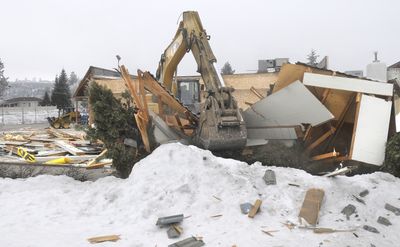Winter’s damages piling up
Storm, floods reached disaster proportions

It’s still too early to assess damages from this season’s snowstorms and floods, but the dollar amount appears to exceed the threshold required for federal disaster assistance to Washington state.
Local and state emergency management officials have been racing the clock to come up with a preliminary assessment of damage to public infrastructure – such as government-owned buildings and roads – to meet a federal deadline.
“We are looking at, combined, maybe $100 million. That’s for both disasters, flooding and snow,” said Rob Harper, a spokesman for the state Emergency Management Division.
Harper stressed that the figure was only an estimate “to give some kind of order to what we are dealing with.” Record snowfall caused damage on both sides of the state, while flooding caused more damage to the West Side.
Over 20 days, 75.5 inches of snow fell on Spokane, according to the National Weather Service. The average winter snowfall is 48 inches.
Rain added to the weight of the snow, causing the roofs of about 50 buildings, private and public, to collapse in Spokane County and putting insurance adjusters and contractors to work. Some businesses remain closed.
State emergency management officials must have an assessment of damage to public infrastructure between Dec. 11 and Jan. 5 ready by the first week in February for the governor to review and submit to the Federal Emergency Management Agency. Agencies may be eligible for as much as 75 percent of uninsured damages, as well as snow removal costs.
The thresholds for meeting the requirements of a disaster declaration are $7.7 million statewide and $1.37 million for Spokane County.
“We have greatly exceeded that,” said Gerry Bozarth, recovery specialist for the county Emergency Management Department.
He declined to say what figure the county submitted to the state, but the cost of damage to Cheney’s Wren Pierson building alone was $800,000, Bozarth said.
“We have these gross numbers from county agencies and school districts,” Bozarth said, adding that it remains to be seen how much of the damage will be covered by insurance.
Insurers were also reluctant to provide exact numbers.
A spokesman for the NW Insurance Council said its 11 member companies estimated $18.7 million in “inspected insured losses” statewide.
“The majority of these claims were frozen pipes and collapsed roofs,” said Darrin Sanger, the council’s communications director.
But the council represents only 25 percent of the state insurance market, Sanger said. Three of the state’s largest insurers – Allstate Insurance, Farmers Insurance Co. and Liberty Mutual Group – did not disclose claims data.
State Farm Insurance spokesman Tim Wade said his company paid out $600,000 for more than 500 claims in Eastern Washington in the last week of December.
In other cases, insurance officials were getting around to inspecting snow-damaged homes and businesses last week.
Work has already begun at Rosauers Supermarket, 1724 W. Francis Ave., where 12,000 square feet of the roof collapsed Dec. 29. Rosauers President Jeff Philipps said damage will run “in the millions.”
After the roof collapsed at the Five Mile neighborhood store, Rosauers closed four of its seven other area stores for a day as a precaution. Shoveling the roofs alone cost the company $150,000, Philipps said.
Repairs to the store will not be completed until May, said D. Dean Haagenson, president of Contractors Northwest Inc., the Coeur d’Alene company hired by Rosauers. Haagenson said owners of damaged businesses should have little trouble finding builders to do repairs during a time of general stagnation in the construction industry.
“I guess there are enough contractors and adjusters out there,” he said.
At Mel’s Nursery at the North Division Y, bookkeeper Jennifer Griffiths said the store hoped to reopen the undamaged part of the store within 30 days after a 40-by-90-foot section of its roof collapsed.
Jeff Kilgore, of Kilgore Construction, which is doing the repair work at Mel’s, called this winter’s snowstorm unprecedented. “The community has to rally to put everything back together,” he said.
Relief to some businesses may come in the form of low-interest loans from the federal Small Business Administration, according to Harper, who said the state also was close to assessing the economic impact of the storms.
Depending on the results of a complicated disaster assistance formula, businesses might be eligible for the loans if they can prove adverse impacts because customers could not get to stores or deliveries could not be made, for example.
Rural areas might be eligible for assistance through the U.S. Department of Agriculture, said Randy Primmer, county executive director for the Farm Service Agency, which serves Spokane and Pend Oreille counties.
Harper said state emergency management officials next week will visit four or five Eastern Washington counties to assess damages to public facilities as part of the statewide request for a disaster declaration.
“We don’t have to see every bit of damage,” Harper said. “We just have to see enough to meet the threshold.